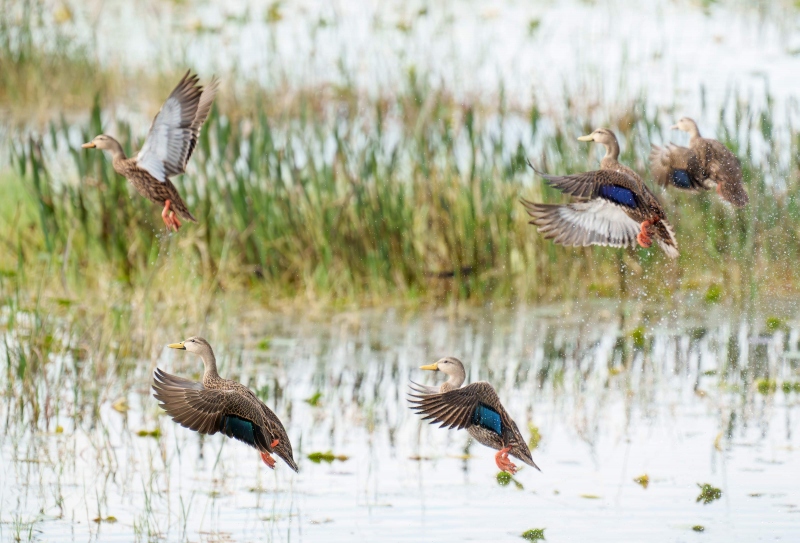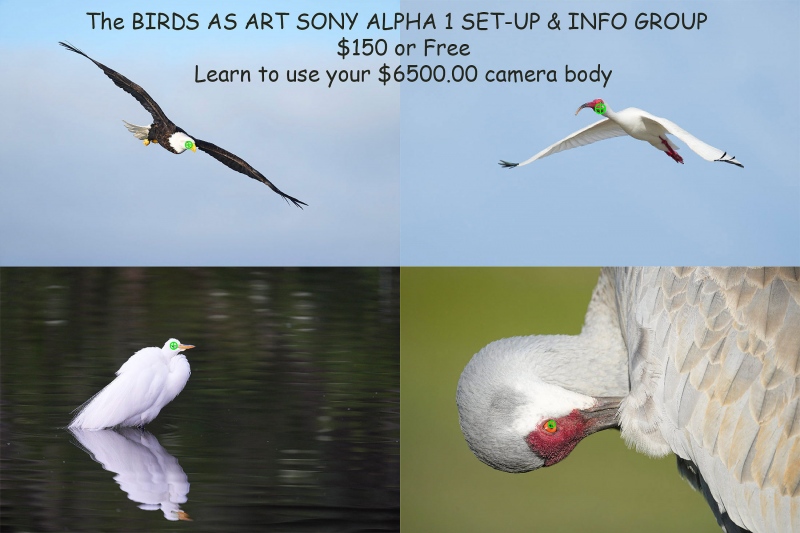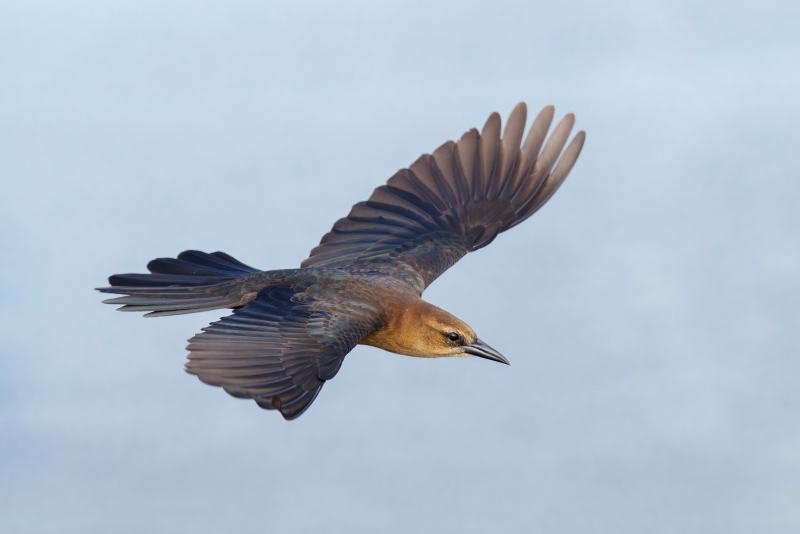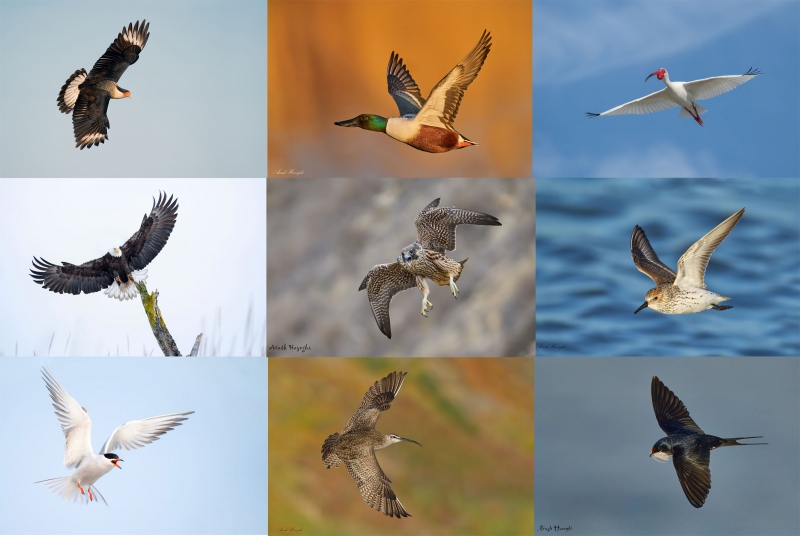Your Call?
Which of today’s two featured peashooter images do you think is the stronger photo? Please leave a comment letting us know why you made your choice.
What’s Up?
I was beyond thrilled yesterday to fill five slots on the 2024 Homer Bald Eagle IPTs. There is now only one spot left on each IPT. Click here and scroll down for INFO on the Homer IPTs. I am still offering a $500 discount on a single IPT, $1500 off if you do both.
I was glad to learn recently of the following Used Gear Page sales:
Good friend and many multiple IPT veteran Indranil Sircar sold his Canon EOS 5D Mark IV in excellent plus condition with several extras for a very low $999.00 soon after is was listed in mid-November 2023.
Multiple IPT veteran Martin Mikulas sold his Sony a9 II body in near-mint condition for a BAA Record-low $2197.00 right after it was listed in early 2023.
Stan Gorlitsky sold his Nikon NIKKOR Z 800mm f/6.3 VR S lens in mint condition for a very low $5400.00 (was listed for $5,496.95) soon after it was listed in early November 2023.
Today is Tuesday 28 November 2023. With the north and NW morning winds, I have not spent much time down by the lake. I will likely take a Vitamin D/health walk this morning with the peashooter rig despite the poor wind direction (NW).
Jim will be sending out the Digital Basics III, Volume I/#2 to the subscriber group this afternoon. See the next blog post for details on Volume I/#2.
Wherever you are a whatever you are doing, I hope that you too have a great day.
Please remember to use the B&H and Amazon links that are found on most blog pages and to use the BIRDSASART discount code at checkout when purchasing your new gear from Bedfords to get 3% back on your credit card and enjoy free second-day air FedEx. Please, also, consider joining a BAA IPT. You will be amazed at how much you will learn!
You can find some great photo accessories (and necessities, like surf booties!) on Amazon by clicking on the Stuff tab on the orange/yellow menu bar above. On a related note, it would be extremely helpful if blog-folks who, like me, spend too much money on Amazon, would get in the habit of clicking on the Amazon logo link on the right side of each blog post when they shop online. As you might expect, doing so will not cost you a single penny, but would be appreciated tremendously by yours truly. And doing so works seamlessly with your Amazon Prime account.
If an item — a Delkin flash card, or a tripod head — for example, that is available from B&H and/or Bedfords, is also available in the BAA Online Store, it would be great, and greatly appreciated, if you would opt to purchase from us. We will match any price. Please remember also to use my B&H affiliate links or to earn 3% cash back at Bedfords by using the BIRDSASART discount code at checkout for your major gear purchases. Doing either often earns you free guides and/or discounts. And always earns my great appreciation.
Used Gear Page Price Drops
Sony FE 135mm f/1.8 GM (Grand Master) Lens
Price reduced $200.00 on 7 March 2023
Price reduced $200.00 on 27 November 2023
Anthony Ardito is offering a Sony FE 135mm f/1.8 GM lens (USA warranty) in like-new condition for a ridiculously low $1298.00 (was $1,698.00). The sale includes the original product box and everything that came in it including the ALC-F82S 82mm front lens cap, the ALC-R1EM rear lens cap, the ALC-SH156 lens hood, the lens case, all factory accessories and manuals, and insured ground shipping via major courier to lower 48 US addresses only. Your item will not ship until your check clears unless other arrangements are made.
Please contact Anthony via e-mail at e-mail.
Prized for its ability to isolate focus, the FE 135mm f/1.8 GM from Sony is a medium telephoto prime characterized by a bright and sophisticated design. It is perfect for portraiture and also excels at close-range sports shooting and as a unique focal length for landscapes. Its Grand Master design prioritizes both sharpness and bokeh quality and the lens also offers fast autofocus AF capabilities and durable build quality. It is designed to achieve notably high resolution and sharpness through the correction of a wide variety of spherical and chromatic aberrations and its bright f/1.8 maximum aperture benefits working in difficult lighting conditions. The rounded 11-blade diaphragm contributes to a pleasing bokeh quality when employing selective focus techniques. Sony & B&H
This superb, high-end medium telephoto lens sells new for $2,098.00. It is the dream lens for all serious portrait photographers. If you have been hoping to find a reasonably-priced copy this lens, grab Anthony’s pretty much new one right now and put $400.00 in savings into your pocket. artie
Canon EOS-1DX Mark II Digital SLR Camera with Extras!
BAA Record-low Price!
Price reduced $200.00 on 25 November 2023
John Nelson is offering a Canon EOS-1DX Mark II dSLR camera in excellent condition for a BIRDS AS ART record low $1399.00 (was $1599.00). The sale includes the original box, one battery, the charger, the front body cap, four (4) 128 128GB CFast memory cards, cfast cards, and insured ground shipping via major courier to lower-48 US addresses only. Your item will not ship until your check clears unless other arrangements are made.
Please contact John via e-mail.
The 1DX Mark II is a rugged, fast Canon professional digital camera body. It features an excellent AF system and high quality image files with great dynamic range. When he used Canon, it was the first choice of Arash Hazeghi, the world’s premier photographer of birds in flight.Two iDX II served as my workhorse bodies for several years. And I loved them. artie
Nikon D500 DSLR Camera Body
BAA Record-low Price!
Price reduced $50.00 on 27 November 2023
Larry Peavler is offering a like-new Nikon D500 DSLR Camera Body with only 2,408 actuations for a BIRDS AS ART Record-Low $699.00 (was $749.00). The sale includes one battery, the charger, the cable, the front body cap, the strap, the original product box, and insured ground shipping via a major carrier to the lower 48.
Please contact Larry via e-mail
The D500 is Nikon’s top-of-the-line crop factor body. It multiplies your focal length by 1.5X. Joe Przybyla and Dan Kearl, both excellent photographers on Bird Photographer’s.Net, use the D500 as their workhorse camera bodies. Joe, the co-author of The BAA Middle of Florida Photographic Site Guide, was after this old dog for a long time to try a D500 when I used Nikon. artie
|
|
|
This image was created on 26 November 2023 on the pier at Indian Lake Estates. While standing at full height, I used the handheld Sony FE 70-200mm f/2.8 GM OSS II lens with the Sony FE 2x teleconverter (zoomed out to 324mm), and The One, the Sony Alpha 1 Mirrorless Digital Camera.. The exposure was determined via Zebras with Exposure Compensation on the Thumb Dial. Multi-metering +1.7 stops in Shutter Priority mode. AUTO ISO set ISO 4000: 1/3200 sec. at f/5.6 (wide open). AWB at 9:06:21am on a variably cloudy morning. Tracking: Zone/AF-C with Bird-Eye/Face Detection performed perfectly. Click on the image to enjoy a high-res version. Image #1: Mottled Ducks — five taking off |
The Peashooter Rig
Over the years I have often carried the 200-600 when taking health or vitamin D walks down by the lake. I love having 600mm at my disposal, but with the a-1, the rig weighs 6 pounds, 10.2 ounces (with a battery and a card) and is 18 1/8 inches in length (with the hood in place). On a 1 1/2 mile walk, lugging the 2-6 around is a real chore. Three days ago, I decided to walk with the 70-200 II, the 2X TC, and an a-1. That turned out to be a good move as the rig weighs only 4 pounds, 9.8 ounces (again, with a battery and a card) and is 18 1/8 inches in length (again, with the hood in place).
Though the smaller rig is only 2 pounds, .4 ounces lighter than the 2-6, that represents slightly more than a 30% drop in weight. Additionally, the length of the 70-200mm rig is almost 25% shorter than the bare 200-600. Comparing the bulk of the two set-ups, the smaller and lighter 70-200 rig seems like a feather when compared to the 200-600.
All of the above assuming that my measurements and my math are correct.
Though I will miss the 600mm maximum focal length of the 200-600 at times, the lighter more versatile, more easily carried, and easier-to-handhold 70-200/2X TC/a-1 combo will be with me whenever I take a walk down by the lake. 400mm is not chicken-feed.
The Sony 70-200mm f/2.8 II GM Lens
Regular readers know that I fell in love with the Sony FE 70-200mm f/2.8 GM OSS II lens from the first moment I used it. I had never seen such a huge improvement in a version II of a lens. Everything about it is better, including and especially AF performance and the ease of zooming in or out. When used with either TC, it completely renders the the Sony 100-400 GM lens obsolete and worthless for those who photograph birds or animals in action. Learn lots more about this great lens here, here, here, and here.
Why Not Manual Exposure Mode?
Yes, competent nature photographers work in Manual (exposure) mode more than 95% of the time on average. When I take my walks with a lens, however, I always work in Shutter Priority mode with AUTO ISO. The key is to assign Exposure Compensation (EC) to the Thumb Dial (rather than ISO as my camera is usually set up). Doing that with a Sony a-1 is of course detailed in the SONY Alpha a1 Set-up and Info Group e-mails. I use that same set-up often — but not always, when creating sunrise and sunset silhouettes against bright colored skies and when creating pleasing blurs in situations where the background is uniformly light-toned. The San Diego IPT is a great place to learn when and how to use this technique. (Click here and scroll down for INFO on the San Diego IPT.) The best news is that it is easy to set this method up with other camera systems, most notably on this side of the pond, that means Canon and Nikon.
The question remains, “Why? go to Shutter Priority Mode with EC and AUTO ISO.” When you are facing a succession of unexpected situations — who knows what I might stumble upon while walking in nature?, this set-up makes much more sense to me than Manual mode. The catch is that you need to be able to quickly analyze each scene, subject and background, so that you can properly set the EC.
As I began my walk onto the pier, it was white-sky-cloudy, so I set the EC to +2.3 stops and the shutter speed to 1/3200, wanting to be ready should something decent fly by. When I saw the five Mottled Ducks getting nervous as I approached them, I raised the lens and acquired focus. As the lake with some scattered marsh grasses was darker overall than the sky, I quickly turned the Thumb Dial two clicks counter-clockwise to reduce the EC from +2.3 stops to +1.7 stops. That turned out to be a brilliant move as the exposure was perfect with only some small areas of water showing as over-exposed.
While the arrangement of the five ducks is not quite perfect, it is pretty sweet. In addition, I love the painterly look and feel of the image. And there are some pretty neat wing positions as well along with lots of flying water droplets. Not bad for a grab shot.
|
|
|
Click on the image to better see the green eye-AF boxes in action. Sony Alpha 1 Flight Photography AF Points! |
The SONY Alpha a1 Set-up Guide and Info Group: $150.00 (or Free)
The SONY Alpha a1 Set-up Guide and Info Group is going great guns as more and more folks chime in with thoughtful questions and experience-based answers. As the a1 is becoming more readily available, more and more folks are getting their hands on this amazing body. By June 1, 2022, the group was up to an astounding 124 lucky and blessed folks. (More than a few folks own two or more a1 bodies! Early on, we discussed the myriad AF options. I gave my opinion as to the best one for flight and general bird photography. The best news is that everyone in the group receives an e-mail that includes a .DAT file with my a1 settings on it, and explicit directions on how to load my settings onto your a1; talk about convenience! I am now offering a .DAT file compatible with firmware update 1.20. Your entry into the group includes a consolidated Sony a1 CAMSETA2 INFO & GUIDE. New a1 folks will now receive six e-mails instead of the previous 28! You will receive new e-mails as they are published. Simply put, this e-mail guide is an incredible resource for anyone with an a1.
All who purchased their Alpha 1 bodies via a BAA affiliate link — B&H or Bedfords — will receive a free Sony Alpha a1 Set-Up Guide and free entry into the Info Updates group after shooting me their receipts via e-mail. (Note: it may take me several days to confirm B&H orders.). Others can purchase their guide here in the BAA Online Store.
|
|
|
This image was also created on 26 November 2023 on the pier at Indian Lake Estates. Again, while standing at full height, I used the handheld Sony FE 70-200mm f/2.8 GM OSS II lens with the Sony FE 2x teleconverter (zoomed out to 240mm for this one), and The One, the Sony Alpha 1 Mirrorless Digital Camera.. The exposure was determined via Zebras with Exposure Compensation on the Thumb Dial. Multi-metering +2.0 stops in Shutter Priority mode. AUTO ISO set ISO 3200: 1/3200 sec. at f/5.6 (wide open). AWB at 9:07:25am on a variably cloudy morning. Tracking: Zone/AF-C with Bird-Eye/Face Detection performed perfectly. Click on the image to enjoy a high-res version. Image #2: Boat-tailed Grackle — dorsal view of female in flight |
The Crapshoot
There are almost always Boat-tailed Grackles on the pier railings. Naturally, as you walk by, they take flight. By evaluating the wind and sky conditions, and noting the pattern of take-offs, it is rarely possible to come up with a good flight chance or two. The smaller, lighter peashooter rig gives me a much better chance of succeeding in this situation than the larger, heavier 200-600.
When this female boat-tailed took flight toward the shore, I got the lens on the bird, acquired focus, panned quickly and erratically, and fired off about 15 frames. I managed to get the whole bird in the frame in only two images. I had one spectacular dorsal flight pose, but that image was not as sharp as today’s Image #2. That surely because I was unable to keep the bird anywhere near the middle of the frame.
When I was shooting Canon and Nikon dSLRs, I could never have envisioned even attempting flight shots of medium sized songbirds. With today’s incredible mirrorless cameras, pretty much anything is possible.
|
|
|
Click on the composite to view a larger version and be even more impressed. The Art & Science of Photographing Birds in Flight with the Sony α-1
|
The Art & Science of Photographing Birds in Flight with the Sony α-1
by Arash Hazeghi and Arthur Morris
First of all, if you use Nikon or Canon (or Olympus or Fuji) gear, do not be put off by the title. While a portion of the guide deals with the Sony α-1, there is a ton of priceless information, tips, and techniques that can help you become a better flight photographer. No matter what system you are using. If you do not use an α-1, be sure to read down to the bottom to save a few bucks.
Arash Hazeghi and Arthur Morris have created the definitive and most comprehensive ever treatise on photographing birds in flight. With more than sixty years of experience photographing birds, they know what you need to know but have not figured out yet! You will be astounded by the depth of their knowledge and the tips they have to offer. More than six months in the making, the guide contains 229 pages, 24,321 words,97 exceptional and inspirational flight images — each with a legendary, enlightening BIRDS AS ART caption, and 22 screen captures. The guide contains a wealth of useful, practical, and for the most part — never-before-available information.
Purchase
Click here to purchase your copy in the BAA Online Store.
What Everyone Will Learn
We will teach you the basic concepts that you need to master to become a great flight photographer along with the techniques used by the world’s best flight photographers.
You will learn that most any telephoto lens can be perfect for flight photography in a given situation; focal lengths for the images in the book range from 200mm to 1200mm and everywhere in between.
We discuss the merits of various lenses in depth, including and especially comparing the 400mm f/2.8 lenses with the 600mm f/4s.
We guide you in getting your hands on the flight photography lens that will best meet your needs. We offer a variety of handholding and rest position tips and include tips on working with a big lens on a tripod when working with a flight lens that is otherwise too heavy for you.
Both authors offer their thoughts on getting the right exposure when photographing birds in flight. You will learn to get the right exposure on foggy days and even when photographing black birds in white sky conditions.
You will learn the tremendous importance of pre-focusing, of finding the bird in the viewfinder quickly, acquiring focus almost instantly (with tips on doing all three).
You will learn the role of image stabilization in flight photography and the best settings.
Both authors share their thoughts on using the focus range limiter switch. In the same vein, you will learn to use Direct Manual Focus to make your flight photography life easier.
All will learn about the best wing positions and the importance of the background with images of birds in flight. With lots of examples.
You will learn about the best shutter speeds (and the best aperture) to use when photographing flying birds.
You will learn to photograph flight while seated and the many advantages of doing so.
You will learn the best methods of controlling high ISO noise.
All will learn to format their flash cards properly and safely.
You will learn what to do when your AF system is temporarily blinded.
All will learn the huge effect that wind strength and direction has on flight photography and to evaluate the quality and direction of the light on both sunny and cloudy days.
You will learn why it is vitally important to shoot aggressively when photographing birds in flight.
You will learn to carefully observe and evaluate a variety of bird behaviors that may shine light on some excellent opportunities for photographing birds in flight. And about getting into the best position from which to photograph.
You will learn to be a much better flight photographer.
What Sony Folks Will Learn
Exactly how Artie uses Zebras to come up with perfect exposure after perfect exposure.
The fine points and recommended settings for Optical Steady Shot (OSS).
The concept of Auto-Focus (AF) tracking in the α-1.
Everything there is to know about the complex Sony autofocus system.
About all the AF patterns, how to quickly switch them, and about those favored by each author. And why.
The Tracking and Non-tracking AF patterns. When and why Arash uses Non-Tracking Zone. And why Artie uses only two AF patterns.
How to set and use Bird Face-Eye detection for flight photography.
How and why to assign various custom functions to the various programmable buttons on the α-1 body.
The perfect settings for the many, many Menu items that are vitally related to flight photography.
How and why the Sony α-1 uses both contrast and phase detection AF to determine focus (and the benefits thereof).
Which are the best memory cards for the Sony α-1.
To quickly access frequently used menu items.
Non-Sony α-1 Discount
Using the honor system, folks who do not use a Sony α-1 body are invited to click here to save $25.00 on the purchase price of the guide.
Typos
With all blog posts, feel free to e-mail or to leave a comment regarding any typos or errors.


















Leave a Reply